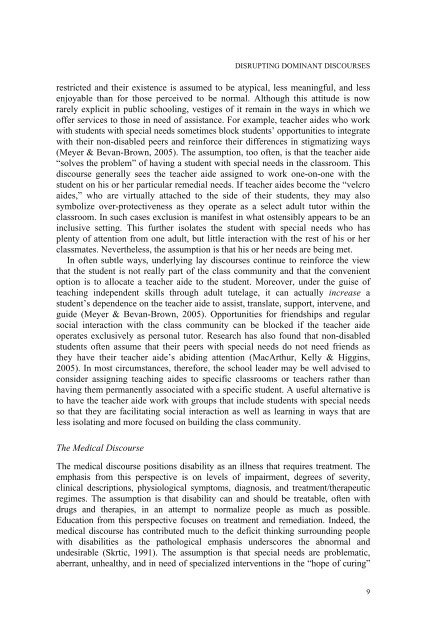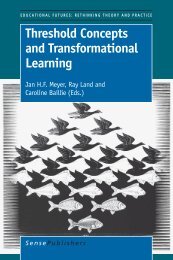Leadership for Inclusion
577-leadership-for-inclusion
577-leadership-for-inclusion
- No tags were found...
You also want an ePaper? Increase the reach of your titles
YUMPU automatically turns print PDFs into web optimized ePapers that Google loves.
DISRUPTING DOMINANT DISCOURSES<br />
restricted and their existence is assumed to be atypical, less meaningful, and less<br />
enjoyable than <strong>for</strong> those perceived to be normal. Although this attitude is now<br />
rarely explicit in public schooling, vestiges of it remain in the ways in which we<br />
offer services to those in need of assistance. For example, teacher aides who work<br />
with students with special needs sometimes block students’ opportunities to integrate<br />
with their non-disabled peers and rein<strong>for</strong>ce their differences in stigmatizing ways<br />
(Meyer & Bevan-Brown, 2005). The assumption, too often, is that the teacher aide<br />
“solves the problem” of having a student with special needs in the classroom. This<br />
discourse generally sees the teacher aide assigned to work one-on-one with the<br />
student on his or her particular remedial needs. If teacher aides become the “velcro<br />
aides,” who are virtually attached to the side of their students, they may also<br />
symbolize over-protectiveness as they operate as a select adult tutor within the<br />
classroom. In such cases exclusion is manifest in what ostensibly appears to be an<br />
inclusive setting. This further isolates the student with special needs who has<br />
plenty of attention from one adult, but little interaction with the rest of his or her<br />
classmates. Nevertheless, the assumption is that his or her needs are being met.<br />
In often subtle ways, underlying lay discourses continue to rein<strong>for</strong>ce the view<br />
that the student is not really part of the class community and that the convenient<br />
option is to allocate a teacher aide to the student. Moreover, under the guise of<br />
teaching independent skills through adult tutelage, it can actually increase a<br />
student’s dependence on the teacher aide to assist, translate, support, intervene, and<br />
guide (Meyer & Bevan-Brown, 2005). Opportunities <strong>for</strong> friendships and regular<br />
social interaction with the class community can be blocked if the teacher aide<br />
operates exclusively as personal tutor. Research has also found that non-disabled<br />
students often assume that their peers with special needs do not need friends as<br />
they have their teacher aide’s abiding attention (MacArthur, Kelly & Higgins,<br />
2005). In most circumstances, there<strong>for</strong>e, the school leader may be well advised to<br />
consider assigning teaching aides to specific classrooms or teachers rather than<br />
having them permanently associated with a specific student. A useful alternative is<br />
to have the teacher aide work with groups that include students with special needs<br />
so that they are facilitating social interaction as well as learning in ways that are<br />
less isolating and more focused on building the class community.<br />
The Medical Discourse<br />
The medical discourse positions disability as an illness that requires treatment. The<br />
emphasis from this perspective is on levels of impairment, degrees of severity,<br />
clinical descriptions, physiological symptoms, diagnosis, and treatment/therapeutic<br />
regimes. The assumption is that disability can and should be treatable, often with<br />
drugs and therapies, in an attempt to normalize people as much as possible.<br />
Education from this perspective focuses on treatment and remediation. Indeed, the<br />
medical discourse has contributed much to the deficit thinking surrounding people<br />
with disabilities as the pathological emphasis underscores the abnormal and<br />
undesirable (Skrtic, 1991). The assumption is that special needs are problematic,<br />
aberrant, unhealthy, and in need of specialized interventions in the “hope of curing”<br />
9




